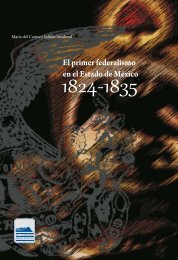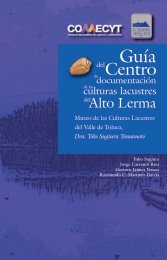Korpus 21 - Vol. 3
Korpus 21 - Nuevas interpretaciones acerca de la consumación de la Independencia.
Korpus 21 - Nuevas interpretaciones acerca de la consumación de la Independencia.
You also want an ePaper? Increase the reach of your titles
YUMPU automatically turns print PDFs into web optimized ePapers that Google loves.
JOHN TUTINO, 18<strong>21</strong>: THE END OF NEW SPAIN, DREAMS OF AN IMPOSSIBLE MEXICO<br />
A different mix of power and loyalty, insurgency<br />
and persistence marked the basins<br />
around Mexico City, the heartland of silver<br />
capitalism. In zones of fertile well-watered<br />
lands –temperate and maize (and wheat)<br />
growing from the Toluca basin to the Chalco<br />
plain, tropical and sugar producing south<br />
around Cuernavaca– pressures of population<br />
growth on community lands had been compensated<br />
by access to seasonal wage work<br />
at nearby estates, negotiated by communitybased<br />
labor captains, keeping community-based<br />
family lives sustainable past 1800.<br />
Pueblos around Toluca showed no interest<br />
in rising with Hidalgo when he arrived in the<br />
fall of 1810; most around Cuernavaca held<br />
aloof from Morelos when he came to Cuautla<br />
in 1810. Most heartland indigenous republics<br />
remained at peace and at work from 1810<br />
to 1820 –a key to sustaining loyal power in<br />
Mexico City as silver capitalism collapsed.<br />
The dry basins of the northern heartland<br />
faced greater challenges during the<br />
last years of silver capitalism, leading many<br />
to years of insurgency after 1810. The arid<br />
lands around Otumba and extending into<br />
the Mezquital lay between the capital and<br />
the mines at Real del Monte. Estates there<br />
raised maize where irrigational allowed,<br />
grazed hogs, and focused on making pulque<br />
to supply taverns in the capital and at the<br />
mines. The richest of oligarchs profited: the<br />
Conde de Regla who ruled mining at Real del<br />
Monte and his wife, Condesa de Jala, all but<br />
monopolized the provision of pulque to the<br />
capital. The turn to pulque in the eighteenth<br />
century served landed oligarchs well, generating<br />
profit while employing little labor.<br />
When population growth left the region’s<br />
Otomí communities short of land to sustain<br />
growing populations around 1800, conflicts<br />
escalated. In the wake of Hidalgo’s revolt,<br />
which passed just west, in 1811 Mezquital villagers<br />
turned to rebellion, attacking estates,<br />
taking produce and land, undermining<br />
commercial production, bringing mining to<br />
a halt at Real del Monte. Silver production<br />
and the revenues it generated plummeted,<br />
as did the earnings of key landed oligarchs<br />
–a challenge from below that began to wane<br />
in 1815, with full pacification delayed to 1816<br />
(Tutino, 2018, Ch.4).<br />
If Mexico City was the financial and commercial<br />
pivot of silver capitalism, and the<br />
surrounding basins mixing mines at Taxco<br />
and Real del Monte and commercial estates<br />
and indigenous republics everywhere, was<br />
its heartland –the Bajío was the productive<br />
engine of silver capitalism, with the mines of<br />
Guanajuato sustained by manufacturing at<br />
Querétaro, San Miguel, and other towns, all<br />
fed by capitalist estates worked by resident<br />
families without rights to land or self-rule.<br />
After centuries of dynamic stability, recent<br />
predations mixing evictions and wage cuts<br />
deepened in the face of draught and profiteering<br />
from 1808 to 1810 –driving the popular<br />
risings that began in September of<br />
1810 and lasted into 1820. Yet insurgency<br />
was not everywhere. Peace and production<br />
held just east around Querétaro, where estate<br />
–dependent communities, more Otomí<br />
than mixed, had faced parallel predations–<br />
cushioned by informal community organizations.<br />
Most stayed at work, claiming gains<br />
in land use and wages too, while sustaining<br />
the regime (Tutino, forthcoming, Ch. 4 on<br />
Guanajuato; Ch. 5 on Querétaro).<br />
Across the rural basins surrounding the<br />
Guanajuato mines, the richest estates in the<br />
kingdom saw tens of thousands rise with Hidalgo<br />
in 1810, then return home to rule rich<br />
irrigated bottomlands and nearby upland<br />
basins through 1818 –with final pacifications<br />
in 1820. Communities took over estates, claimed<br />
land for family production, and sustained<br />
guerrilla bands. The limited mining that<br />
continued at Guanajuato after 1812, was carried<br />
on by independent workers who gave<br />
small shares to mine owners, then sold ore<br />
to refiners –all sustained by the produce of<br />
insurgent communities. Mine workers and<br />
rural families claimed productive autonomies<br />
as silver capitalism fell (Tutino, 1998,<br />
and forthcoming, Ch. 3).<br />
When rural pacification began in 1818, loyalist<br />
commanders learned that Bajío communities<br />
would only accept amnesties when<br />
guaranteed rights to cultivate lands they<br />
had claimed in insurgency and worked for<br />
342


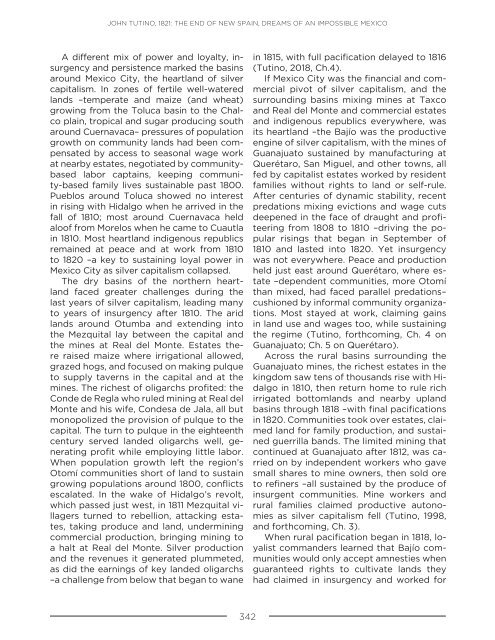
![bicentenario_1[V2]](https://img.yumpu.com/68677971/1/167x260/bicentenario-1v2.jpg?quality=85)
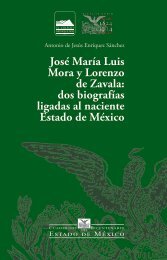
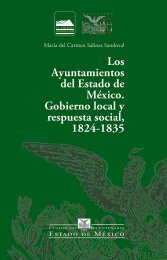

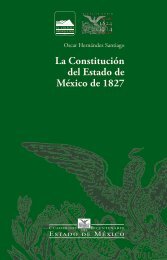
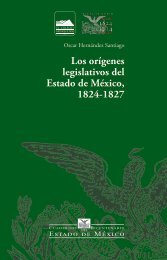
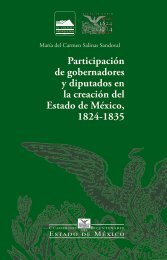
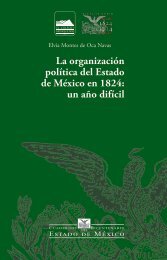
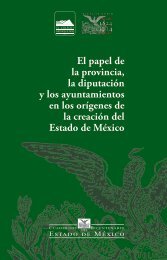

![El_primer_federalismoEM[final]_compressed (2)](https://img.yumpu.com/68483279/1/178x260/el-primer-federalismoemfinal-compressed-2.jpg?quality=85)
